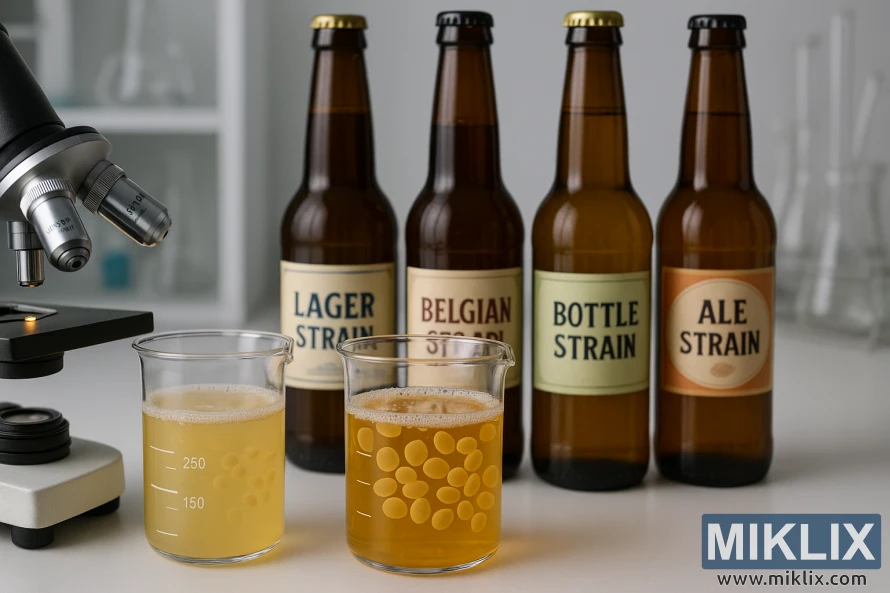Image: Comparing Beer Yeast Strains
Published: September 18, 2025 at 8:48:39 PM UTC
A clean lab scene shows two beakers with distinct yeast cultures, a microscope, and labeled beer bottles, highlighting yeast strain analysis.
The image presents a meticulously arranged laboratory scene designed to highlight the comparison of different beer yeast strains in a clean, controlled environment. The composition is in landscape orientation and has a strong sense of depth, moving from sharply detailed elements in the foreground to softly blurred structures in the background. The overall mood is one of scientific precision and analytical focus, emphasizing the microscopic and biochemical qualities of brewing yeasts within the context of beer production.
In the foreground, two glass beakers are prominently displayed on a pristine white benchtop. Each beaker is filled with a different liquid medium that represents two distinct yeast cultures. The beaker on the left contains a pale golden liquid with a hazy, slightly opaque quality, suggesting an active suspension of yeast cells. Small, round yeast colonies or clusters are visible floating within the fluid, rendered with a macro-style clarity that highlights their spherical, semi-translucent structure. The beaker on the right holds a deeper amber liquid with a richer hue, and within it, numerous larger yeast cells or colonies are suspended. These appear more densely packed and slightly more opaque than those in the left beaker, indicating differences in cell morphology or density between the strains. Both beakers are marked with precise metric measurement lines in white, showing milliliter gradations, reinforcing the scientific and experimental tone of the scene.
A compound microscope stands to the left of the beakers, its metallic objective lenses gleaming softly under the controlled lighting. The microscope’s stage is slightly out of focus, but its presence emphasizes the notion that these yeast cultures are being closely studied and analyzed at a cellular level. The lens barrels catch reflections from the laboratory lights, adding subtle highlights that contrast against the matte surfaces of the microscope’s body. The placement of the microscope at the edge of the frame implies that it has just been used to inspect the samples in the beakers, tying the visual elements together into a narrative of ongoing research.
In the middle ground, a row of four brown glass beer bottles stands upright in a neat line. Each bottle carries a distinct label identifying a different yeast strain or style of beer. From left to right, the labels read: “Lager Strain”, “Belgian Strain”, “Bottle Strain”, and “Ale Strain.” These labels are styled with simple, bold typography that evokes traditional brewery aesthetics while remaining clean and scientific in presentation. The bottles are evenly spaced and symmetrically aligned, acting as symbolic representations of the finished products that result from each yeast strain’s fermentation characteristics. The glass bottles subtly reflect the surrounding light, and their amber-brown coloration contrasts harmoniously with the lighter tones of the liquids in the beakers.
In the background, the laboratory environment recedes into a soft blur, creating depth without distracting from the main subjects. Various pieces of laboratory glassware—such as flasks, beakers, and graduated cylinders—can be seen arranged on shelves and countertops. They are mostly colorless or faintly tinted, catching diffused highlights that hint at the sterile and orderly nature of the workspace. The blurred setting suggests a fully equipped, modern lab environment while ensuring that the viewer’s attention stays centered on the yeast samples and beer bottles.
The lighting is soft, even, and well-diffused, eliminating harsh shadows and emphasizing the clarity and purity of the glassware, liquids, and equipment. This lighting choice enhances the macro-style detail of the yeast cells in the beakers, giving them a delicate three-dimensional presence. The overall color palette is restrained and cohesive, dominated by neutral whites and grays punctuated by the warm amber and golden hues of the liquids and bottles. The resulting atmosphere feels calm, clinical, and highly focused, reflecting the analytical approach scientists take when evaluating brewing yeast performance.
The image is related to: Fermenting Beer with Lallemand LalBrew CBC-1 Yeast

